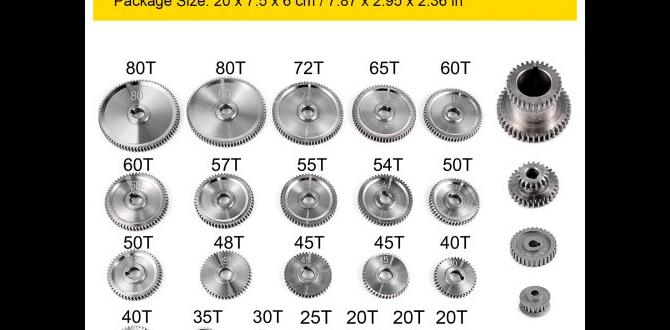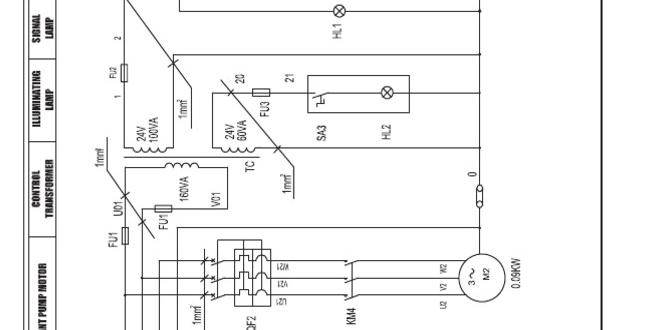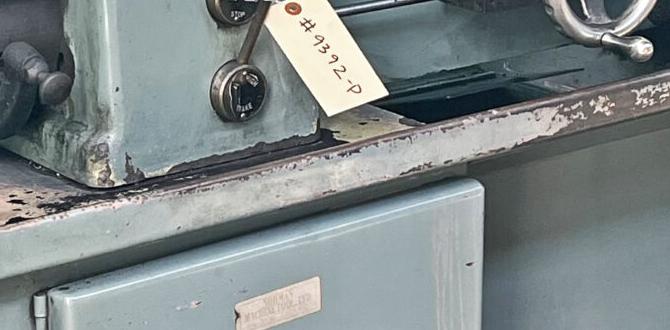Carbide end mills, especially those with a reduced neck and 1/8-inch or 6mm shank, are a game-changer for eliminating chatter in woodworking. They offer superior sharpness and durability, leading to cleaner cuts and smoother finishes, making them essential for any serious woodworker.
Hey everyone, Daniel Bates here from Lathe Hub! If you’ve ever been frustrated by that maddening vibration, or “chatter,” when milling wood, you’re not alone. It’s like a tiny drum solo happening on your workpiece, leaving behind ugly, wavy lines that ruin a perfectly good project. It can make you doubt your skills, but I’m here to tell you it’s often just a tool or technique issue. The good news? There’s a surprisingly simple and effective solution that can transform your milling experience. We’re talking about carbide end mills, and how specific types, like those with a reduced neck and smaller shanks, are absolute wizards at taming chatter. Stick around, and we’ll break down exactly why they work so well and how you can start using them to achieve those beautifully smooth finishes you’ve been dreaming of.
Understanding the Dreaded Chatter
Before we dive into the magic of carbide end mills, let’s quickly chat about what chatter actually is. Think of it as a harmonic vibration. When your cutting tool isn’t smoothly slicing through the material, it can bounce, causing small, repetitive impacts. This bouncing is what creates those visible lines on your wood. Several things can cause this:
Tooling Issues: A dull or damaged cutter, an unbalanced tool, or a cutter that’s too large for the material or machine.
Machine Rigidity: A flimsy CNC machine, loose spindle bearings, or a weak hold-down on your workpiece.
Workpiece Material: Some woods are simply more prone to vibration than others.
Cutting Parameters: Too fast a feed rate, too slow a spindle speed, or too deep a cut.
These factors can combine to create a noisy, frustrating cutting experience, and the results are almost always less than perfect.
Why Carbide is a Woodworker’s Best Friend
When we talk about cutting tools, two main materials come to mind: high-speed steel (HSS) and carbide. While HSS has been around forever and has its place, carbide is where the magic happens for demanding tasks like milling wood, especially when fighting chatter.
Carbide, specifically tungsten carbide, is incredibly hard and durable. This means:
Keeps its Edge Longer: Carbide cutters stay sharp much longer than HSS. A sharp tool cuts cleaner and with less force, which is crucial for reducing vibration.
Withstands Higher Temperatures: Milling can generate heat. Carbide handles this heat better, maintaining its hardness and cutting ability.
More Brittle, but Stronger: While carbide is more brittle than steel, it’s significantly harder. When properly supported, this hardness translates to superior cutting performance.
For woodworking, where we’re often dealing with abrasive woods or needing to achieve very fine finishes, carbide is a clear winner.
The Genius of the Carbide End Mill for Wood
Now, let’s zoom in on the carbide end mill and why it’s so effective at reducing chatter. It’s not just any carbide end mill, though. Specific design features make them ideal for wood.
1. Reduced Neck Design: The Secret Weapon
This is where things get really interesting. A “reduced neck” end mill has a section behind the cutting flutes that is slightly smaller in diameter than the cutting head.
What it does: This narrow neck area allows the flutes to clear chips more effectively. When chips don’t clear well, they can get recut, leading to friction, heat, and vibration – hello, chatter!
Why it’s great for wood: Wood produces a lot of fluffy chips. A reduced neck helps ensure these chips are ejected cleanly, leaving a clear path for the cutter and reducing the chances of it getting bogged down. This smooth operation is key to chatter-free cuts.
2. Shank Size Matters: 1/8 Inch and 6mm Options
You’ll often see carbide end mills specified by their shank diameter, with 1/8 inch (about 3.175mm) and 6mm being very common in smaller CNC routers and hobbyist machines.
Why smaller shanks are beneficial:
Less Chatter: Smaller diameter shanks mean a lighter tool. A lighter tool puts less stress on your machine’s spindle and motion system, contributing to less vibration.
Flexibility: Smaller shank end mills often have a longer reach or can be used in collets designed for smaller diameters, offering more versatility for detailed work.
Cost-Effective: Generally, smaller tools are less expensive, making them accessible for hobbyists.
SEO Keywords in Action: When you’re searching for tools to combat chatter, looking for “carbide end mill 1/8 inch 6mm shank reduced neck for wood reduce chatter” will lead you directly to the tools specifically designed for this problem.
3. Multi-Flute Designs: More Slices, Smoother Finish
Carbide end mills designed for wood often come with more flutes (the cutting edges spiraling up the tool) than those typically used for metal.
2-Flute: Good for chip evacuation in softer materials, but can sometimes lead to more chatter if feed rates aren’t optimized.
3-Flute: A good balance for wood. Offers better chip clearance than a 4-flute and a smoother finish than a 2-flute.
4-Flute (or more): Can provide a very smooth surface finish but requires faster feed rates to maintain chip load and prevent re-cutting. For plastics and harder woods, where chip evacuation is less of an issue, these can be excellent.
For general woodworking and chatter reduction, a 3-flute or even a specialized “O-flute” (which has a polished, single cutting edge designed for plastics and wood) can be fantastic.
Choosing the Right Carbide End Mill for Your Wood Project
Not all wood projects are the same, and neither are all end mills. Here’s a breakdown to help you choose:
Types of Carbide End Mills for Wood
| Type of End Mill | Best For | Pros | Cons | Chatter Reduction Potential |
| :—————————– | :——————————————————————————————————– | :—————————————————————————————————————————— | :——————————————————————————————————————————- | :————————– |
| Single Flute (O-Flute) | High-quality finish, plastics, softwoods, hardwoods, engraving. | Excellent chip evacuation, smooth finish, can run at higher speeds. | Can be less aggressive than multi-flute, may require higher feed rates. | High |
| Two Flute | Aggressive material removal, general routing, softer woods. | Good for clearing material quickly, cost-effective. | Chip evacuation can be an issue in sticky woods, potentially more prone to chatter if parameters aren’t right. | Medium |
| Three Flute | Excellent all-rounder for wood, good balance of finish and speed. | Good chip evacuation and surface finish, versatile for various woods. | Might not be the absolute smoothest finish compared to O-flute or high-quality 4-flute on certain materials. | High |
| Four Flute (or more) | Very smooth finishes, harder woods, materials where chip evacuation is less of a concern (like acrylics). | Superior surface finish, can handle tougher materials. | Chip evacuation is a challenge in woods, requiring careful parameter selection to avoid recutting and vibration. | Medium-High (with optimization) |
| Compression/Dovetail Bits | Creating joints, clean top and bottom edges simultaneously. | Creates clean edges on both sides of the material. Dovetail bits are strong. | Can be specialized, may require specific machine setups for optimal use. | Medium |
| Ball Nose End Mill | 3D carving, reliefs, smooth contours. | Creates rounded profiles, essential for organic shapes. | Less efficient for flat areas, can sometimes be more prone to chatter on flat surfaces if parameters are not dialed in. | Medium |
Considering the Flute Count
For maximum chatter reduction, start with a 3-flute O-flute or a well-designed 3-flute end mill. These are generally forgiving and provide excellent results.
If you’re doing a lot of fine detail work or engraving, an O-flute is ideal. The polished flute helps eject chips cleanly and prevents fuzziness.
For aggressive material removal, a 2-flute might be your go-to, but be extra mindful of your feed and speed to avoid chatter.
Material Considerations
Softwoods (Pine, Cedar): Tend to be less abrasive and easier to cut. A 2 or 3-flute O-flute or standard end mill works well.
Hardwoods (Oak, Maple, Walnut): More abrasive and dense. You’ll benefit greatly from the durability and sharpness of carbide. A 3-flute is often perfect.
Plywood and MDF: Can be dusty and abrasive. Carbide stands up to this well, and good chip evacuation is key.
How to Use Your Carbide End Mill to Reduce Chatter: Step-by-Step
Okay, you’ve got your shiny new carbide end mill. What next? It’s not just about the tool; it’s about how you use it!
Step 1: Secure Your Workpiece
This is non-negotiable. Any movement of the workpiece during milling is a direct invitation to chatter.
Use clamps: Ensure your workpiece is firmly secured to your machine bed. Use multiple clamps if necessary.
Consider templates or jigs: For repetitive tasks or to add rigidity, use templates or jigs that are themselves well-secured.
Vacuum hold-down: If your machine has a vacuum table, ensure it’s functioning correctly and creating a strong seal.
Step 2: Install the End Mill Correctly
A loose end mill is dangerous and a primary cause of chatter and poor finish.
Use the right collet: Make sure the collet you use matches the shank diameter of your end mill. A 1/8 inch end mill needs a 1/8 inch collet or a collet reducer.
Clean everything: Ensure the collet and the collet nut are free of dust and debris. A tiny speck can cause imbalance.
Insert firmly: Insert the end mill into the collet, ensuring it’s seated properly. Don’t push it too far in, but ensure a good portion of the shank is gripped.
Tighten securely: Tighten the collet nut firmly. Some machines have torque specifications; if not, snug is good, but don’t over-torque and risk damaging the collet or spindle.
Step 3: Set Your Cutting Parameters (Feed Rate & Spindle Speed)
This is often where the magic happens for chatter reduction. These numbers depend heavily on your specific machine, wood type, and end mill.
Consult your machine’s manual or manufacturer recommendations: They often provide starting points for feed and speed.
Start conservative: It’s always better to start with slower feed rates and slightly higher spindle speeds than aggressively.
Understand Chip Load: This is the thickness of material removed by each cutting edge per revolution.
`Chip Load = Feed Rate / (Spindle Speed Number of Flutes)`
For wood, you want to remove enough material to make a clean cut without overloading the tool or machine. Too small a chip load can lead to rubbing and chatter. Too large can break the tool or stall the motor.
A common starting point for 1/2 inch (12.7mm) carbide end mills on hardwoods might be:
Spindle Speed: 18,000 RPM
Feed Rate: 60-100 inches per minute (IPM) or 1500-2500 mm per minute (MPM)
For smaller 1/8 inch (3.175mm) or 6mm end mills, you might need to adjust these. Often, smaller diameter tools can run faster spindle speeds but require slower feed rates to maintain an appropriate chip load and avoid deflection.
Listen and Watch: As the cut progresses, listen to the sound. A smooth hum is good; a high-pitched whine or erratic buzzing is chatter. Visually inspect the cut. If you see tiny “fuzzies” or rough lines appearing behind the cutter, your feed rate might be too low, or your spindle speed too high for that particular chip load.
Step 4: Optimize Depth of Cut
Taking too deep a cut puts excessive load on the end mill and your machine.
Roughing vs. Finishing Passes:
Roughing Pass: Remove the bulk of the material with a relatively deep cut (e.g., 1/4 inch to 1/2 inch, or 6mm to 12mm, depending on the tool and machine rigidity).
Finishing Pass: Make a final, shallow pass (e.g., 0.010 – 0.030 inch, or 0.25mm – 0.75mm) at your final desired dimensions. This pass doesn’t remove much material but cleans up any minor imperfections and ensures the final dimensions are perfect without stressing the tool.
Step Down (for pocketing): When cutting pockets, don’t try to cut the entire depth in one pass. Use your CAM software to set a “step down” (the depth of each individual pass), which is typically a fraction of the tool diameter.
Step 5: Ensure Good Chip Evacuation
Even with a reduced neck, you need to help your machine clear chips.
Air Blast/Dust Collection: Ensure your dust collection system is connected and working effectively. Some systems also have an air blast feature that helps blow chips away from the cutting zone.
Manual Clearing: For very deep pockets or sticky woods, you might occasionally need to pause the cut and clear chips manually with a brush or shop vac (with the machine safely powered down).
Advanced Tips and Tricks for Chatter-Free Milling
Beyond the basics, a few other things can help you achieve that buttery-smooth finish.
True Running and Spindle Health
Runout: This refers to how much the tip of your end mill wobbles when the spindle rotates. High runout is a major contributor to chatter.
Check your collet: Ensure it’s clean and free of damage.
Check your spindle: If you suspect runout, it might be time for a professional bearing check or spindle service. Keeping your spindle lubricated and maintaining it according to the manufacturer’s schedule is vital. You can check for runout by chucking up a dial indicator and measuring the runout at the tip of a test bar or end mill. A good target is less than 0.001 inches (0.025mm).
Spindle Balance: Some high-speed spindles have balanced tool holders or collets. Ensure these are used and maintained if applicable to your machine.
Tool Holder and Collet Selection
High-Quality Collets: Invest in good quality collets. Cheap ones can have imprecise bores and lead to runout. ER collets are a popular choice for their precision and wide gripping range.
Collet Chucks: For more demanding applications, especially on larger machines, a shrink-fit tool holder or a precision collet chuck can offer superior runout and rigidity compared to a standard collet nut setup.
CAM Software Optimization
Leads and Lifts: In your CAM software (the program that generates the machine toolpaths), use “leads” (entry paths) and “lifts” (exit paths) that aren’t too abrupt. Smooth entry and exit reduce shock to the tool and workpiece.
Ramp Plunging: Instead of plunging straight down into the material (which can be hard on the tool and cause vibration), use a ramp plunge if your software supports it. This means the tool enters the material at an angle.
Toolpath Strategy:
Climb Milling vs. Conventional Milling: For most woodworking with standard end mills, climb milling is preferred. In climb milling, the cutter rotates in the same direction as it feeds into the material. This results in a thinner chip at the start and a thicker chip at the end, generally leading to a better finish and less vibration. Conventional milling, where the cutter rotates against the feed direction, can be rougher on wood and more prone to tear-out and chatter.
Rest Machining: For complex shapes, use rest machining passes to avoid the cutter trying to remove too much material at once.
Material Specific Strategies
Sticky Woods: Woods like Padauk or Wenge can be “sticky” and produce gummy chips. You might need slightly faster spindle speeds and a more aggressive feed rate to ensure clean cuts and prevent chip buildup in the flutes.
Gummy Woods: Some woods, like pine, can have resinous areas. Carbide’s sharpness and heat resistance help here, but optimizing chip load is still key.
External Authoritative Resources
For further reading on machining principles that apply to woodworking CNCs, consider exploring these resources:
Machinery’s Handbook: A comprehensive reference for metalworking and machining that contains fundamental principles applicable to understanding cutting forces and tool geometry. While heavily metal-focused, concepts of chip load and cutting parameters are universal. You can often find sections online or purchase the latest edition.
National Institute of Standards and Technology (NIST): NIST provides numerous publications and data on manufacturing processes. While often very technical, they are a source of authoritative data on material properties and machining science




